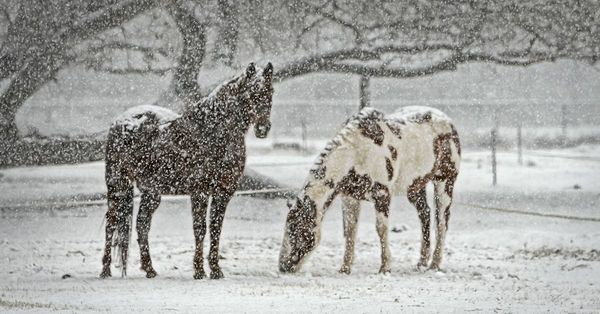The Equine Element: Understanding How Climate Impacts Horse Performance
- Dec 2, 2023
- 2 min read

Climate plays a substantial role in shaping the health, well-being, and performance of our equine companions. Horses are remarkably adaptable creatures, but varying environmental conditions can significantly influence their comfort, health, and athletic capabilities. Let's explore how climate affects horse performance and what measures can be taken to ensure their optimal well-being in different climatic conditions.
The Impact of Climate on Horses:
Temperature Extremes: Both hot and cold temperatures can challenge a horse's physiology. Heat can lead to dehydration, heat stress, and fatigue, while extreme cold can impact joint flexibility, increase energy expenditure, and affect respiratory health.
Humidity Levels: High humidity, especially in combination with heat, can hinder a horse's ability to dissipate body heat, leading to increased risk of heat-related issues. Conversely, extremely dry climates might cause dehydration and skin conditions.
Seasonal Changes: Variations in seasons affect horses differently. Winter might bring challenges like icy footing, snow accumulation, and increased energy requirements for warmth, while summer might entail managing heat stress and insect-related issues.
Strategies for Managing Climate Impact:
Proper Shelter: Providing adequate shelter that shields horses from harsh weather elements, including extreme heat, cold, wind, rain, or snow, is crucial for their comfort and well-being.
Hydration and Electrolyte Balance: Ensuring constant access to clean water and electrolyte supplements during hot weather helps prevent dehydration and maintains electrolyte balance.
Appropriate Nutrition: Adjusting feed and nutrient intake based on climate changes helps horses meet their energy needs for temperature regulation and sustains their overall health.
Grooming and Skin Care: Regular grooming, especially in hot and humid climates, prevents skin issues caused by sweat build-up or insect bites. In dry climates, moisturizing the skin helps prevent dryness and cracking.
Exercise and Rest Schedules: Adjusting exercise routines to cooler parts of the day in hot weather and considering indoor exercise during extreme cold safeguards horse health.
Insect Control: Effective measures against insects, such as fly masks, sprays, or shelter, are crucial in preventing irritation and diseases transmitted by insects.
Understanding Horse Acclimatization:
Horses can acclimate to changes in climate to some extent, gradually adjusting their physiological responses to better cope with environmental challenges. However, this adaptation process takes time, and sudden changes in climate can stress the horse's system.
Conclusion:
In conclusion, recognizing the impact of climate on horse performance is fundamental for their overall health and success in various activities. Owners, trainers, and caretakers must consider and adapt management practices to suit the specific climatic conditions their horses encounter. By providing adequate shelter, nutrition, hydration, and proper care, we can help our equine companions thrive and perform at their best, regardless of the challenges posed by varying climates. Understanding and addressing these climate-related factors contribute significantly to ensuring the comfort, health, and optimal performance of our beloved horses.
%20(1).png)
Comments